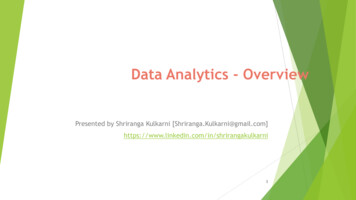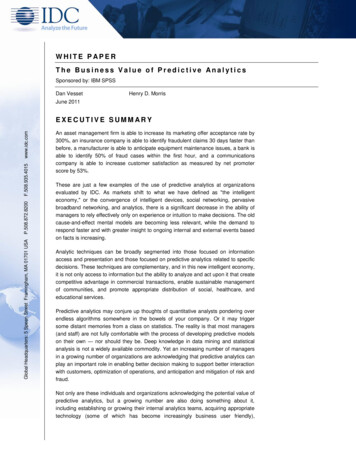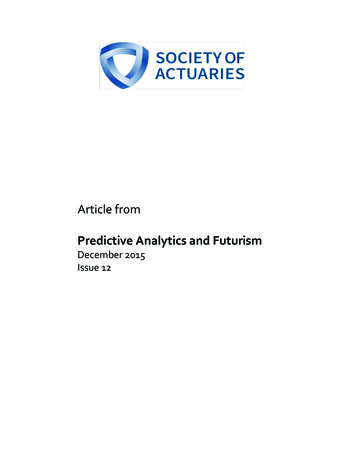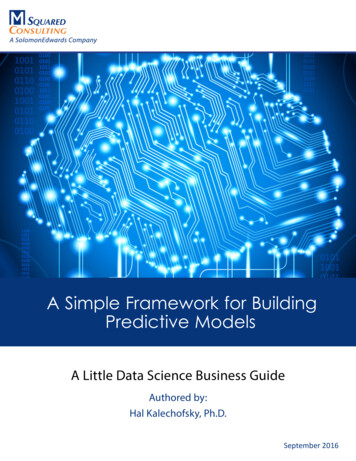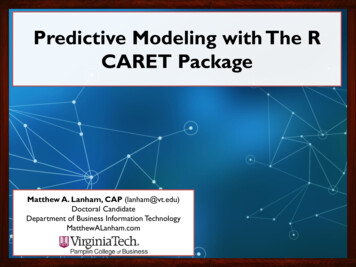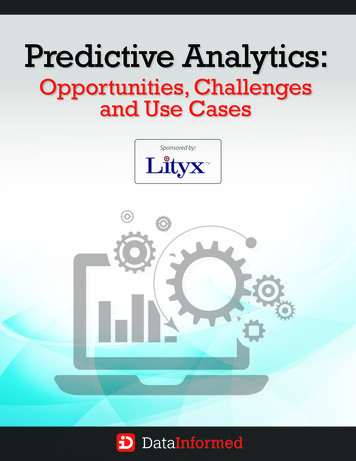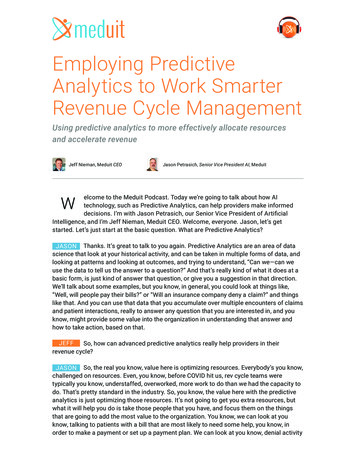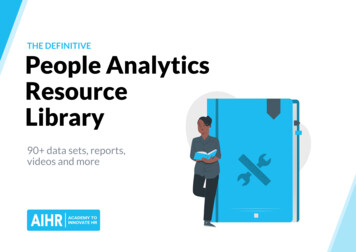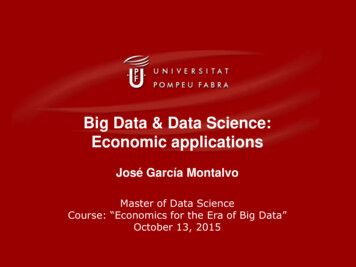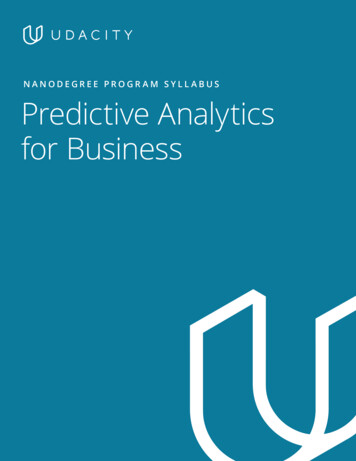
Transcription
NANODEGREE PROGR AM SYLL ABUSPredictive Analyticsfor Business
OverviewThis Nanodegree program prepares you for a career in predictive analytics, andenables you to master a scientific approach to solving problems with data. You’ll build fluency in two leadingsoftware packages: Alteryx, a tool that enables you to prepare, blend, and analyze data quickly; and Tableau, apowerful data visualization tool. Over the course of the program, you’ll learn to: Create mental models to clearly define business issues Visualize and prepare data to improve efficacy of predictive models Identify and implement a variety of predictive modeling techniquesI N CO L L A B O R AT I O N W I T HEstimated Time:3 Months at10hrs/weekFlexible Learning:Self-paced, soyou can learn onthe schedule thatworks best for youPrerequisites:Algebra,DescriptiveStatistics, andExcelTechnical MentorSupport:Our knowledgeablementors guide yourlearning and arefocused on answeringyour questions,motivating you andkeeping you on trackPredictive Analytics for Business 2
Course 1: Problem Solving with AdvancedAnalyticsIn this course, we give you a framework to help you organize and plan your analytical approach. We also introduceboth simple Linear Regression and Multiple Linear Regression.A home-goods manufacturer wants to predict expected profits froma catalog launch. You will apply a framework to work through theproblem and build a linear regression model to provide results and arecommendation.Course ProjectPredict Sales for aCatalog LaunchLEARNING OUTCOMESLESSON ONEThe ProblemSolving Framework Learn a structured framework for solving problems withadvanced analyticsLESSON TWOSelecting anAnalyticalMethodology Select the most appropriate analytical methodology based onthe context of the business problemLESSON THREELinear Regression Build, validate, and apply linear regression models to solve abusiness problemPredictive Analytics for Business 3
Course 2: Data WranglingData Wrangling is at the core of all data activity. In this course you learn how to work with different datatypes,dirty data, and outliers. You will also learn how to reformat data and join data from different sourcestogether.Course ProjectCreate an AnalyticalDatasetA pet store chain is selecting the location for its next store. You willuse data preparation techniques to build a robust analytic datasetand use it to build a predictive model to select the best location.LEARNING OUTCOMESLESSON ONEUnderstandingData Understand the most common data types Understand the various sources of dataLESSON TWOData Issues Identify common types of dirty data Make adjustments to dirty data to prepare a dataset Identify and adjust for outliersLESSON THREEData Formatting Summarize, cross-tabulate, transpose, and reformat data toprepare a dataset for analysisLESSON FOURData Blending Join and union data from different sources and formatsPredictive Analytics for Business 4
Course 3: Classification ModelsClassification models are a powerful tool for business analyst. In this course, you learn more aboutbinary and non-binary classification models and how to use them to drive business insights.Course ProjectPredict Loan DefaultRiskA bank recently received an influx of loan applications. You will buildand apply a classification model to provide a recommendation onwhich loan applicants the bank should lend to.LEARNING OUTCOMESLESSON ONEClassification Problems Understand the fundamentals of classification modelingand how it differs from modeling numeric dataLESSON TWOBinary ClassificationModels Build logistic regression and decision tree models Use stepwise to automate predictor variables selection Score and compare models and interpret the resultsLESSON THREENon-BinaryClassification Models Build and compare forest and boosted models andinterpret their results Score and compare models and interpret the resultsPredictive Analytics for Business 5
Course 4: A/B TestingHelping businesses make the best decisions is an essential part of Business Analysis. Planning and executingthe analysis of an AB test allow you to provide confident recommendations. In this course, you learn how tocreate, execute, and analyze an AB test.Course ProjectA/B Test a Menu LaunchA chain of coffee shops is considering launching a new menu. Youwill design and analyze an A/B test and write up a recommendationon whether the chain should introduce the new menu.LEARNING OUTCOMESLESSON ONEA/B TestingFundamentals Understand the fundamentals of A/B testing, includingselecting target and control units and variables and theduration of a testLESSON TWORandomized DesignTests Select test and control variables and understand the iimportance of sample size Design a randomized design A/B test and analyze theresultsLESSON THREEMatched Pair DesignTests Match test units to control units Design a matched pair design A/B test and analyze theresultsLESSON FOURMatched Pair Practice Use trend and seasonality as control variables for amatched pair design A/B testPredictive Analytics for Business 6
Course 5: Time Series ForecastingTime Series Forecasting is a powerful analytical tool. In this course, you learn how ETS and ARIMA models areused to forecast data and how they deal with trends and seasonality. These skills will be evaluated in the finalproject.Course ProjectForecast Video GameDemandA video game producer is planning production levels. You will usetime series forecasting models to forecast monthly demand andprovide a recommendation to help match supply to demand.LEARNING OUTCOMESLESSON ONEFundamentals of TimeSeries Forecasting Understand trend, seasonal, and cyclical behavior of timeseries dataLESSON TWOETS Models Use time series decomposition plots Build out an ETS model in AlteryxLESSON THREEARIMA Models Stationarize data through differencing, a process thatprepares data for ARIMA modeling Build out an ARIMA model in AlteryxLESSON FOURAnalyzing andVisualizingResults Use holdout samples to compare models and select thebest one for a business problem Visualize your forecasts through various plotsPredictive Analytics for Business 7
Course 6: Segmentation and ClusteringSegmentation and Clustering are effective methods for finding patterns in your data. In this course, you learnhow to prepare data to be clustered appropriately and interpret results.Course ProjectCombine PredictiveTechniquesA grocery store chain is planning a significant expansion. You will usemultiple analytical techniques to provide recommendations on howto expand. After completing the project, you will feel comfortablecombining predictive techniques and delivering results to complexbusiness problems.LEARNING OUTCOMESLESSON ONESegmentationFundamentals Understand the difference between localization,standardization, and segmentationLESSON TWOPreparing Data forClustering Scale data to prepare a dataset for cluster modeling Select variables to include based on the business contextLESSON THREEVariable Reduction Use principal components analysis (PCA) to reduce thenumber of variables for cluster modelLESSON FOURClustering Models Select the appropriate number of clusters Build and apply a k-centroid cluster modelLESSON FIVEValidating and ApplyingClusters Validate the results of a cluster model Visualize and communicate the results of a cluster modelLESSON SIXCreating VisualizationWith Tableau Become proficient in basic Tableau functionality, includingcharts, filters, hierarchies, etc. Create calculated fields in TableauPredictive Analytics for Business 8
Our Classroom ExperienceREAL-WORLD PROJECTSBuild your skills through industry-relevant projects. Getpersonalized feedback from our network of 900 projectreviewers. Our simple interface makes it easy to submityour projects as often as you need and receive unlimitedfeedback on your work.KNOWLEDGEFind answers to your questions with Knowledge, ourproprietary wiki. Search questions asked by other students,connect with technical mentors, and discover in real-timehow to solve the challenges that you encounter.WORKSPACESSee your code in action. Check the output and quality ofyour code by running them on workspaces that are a partof our classroom.QUIZZESCheck your understanding of concepts learned in theprogram by answering simple and auto-graded quizzes.Easily go back to the lessons to brush up on conceptsanytime you get an answer wrong.CUSTOM STUDY PLANSCreate a custom study plan to suit your personal needsand use this plan to keep track of your progress towardyour goal.PROGRESS TRACKERStay on track to complete your Nanodegree program withuseful milestone reminders.Predictive Analytics for Business 9
Learn with the BestPatrick NussbaumerBen BurkholderI N S T R U C TO RI N S T R U C TO RPatrick Nussbaumer is TechnicalActivation Director at Alteryx, Inc. Priorto Alteryx, Patrick has spent the past20 years in a variety of roles focused ondata analysis, telecommunications, andfinancial services industries.Ben Burkholder is a senior solutionengineer at Alteryx, Inc. In this role heworks extensively with clients to helpdevelop plans to solve complex businessproblems around data preparation,geospatial analysis, and predictiveanalytics.Maureen WolfsonRod LightI N S T R U C TO RI N S T R U C TO RMaureen Wolfson is a Solution Engineer atAlteryx, Inc. She has more than 20 years ofdata analysis expertise specializing in data,customer and geospatial analysis.Rod Light is a Solutions Engineer PracticeLead at Alteryx, where he helps customersand prospects design data analyticssolutions for their businesses using Alteryx.Predictive Analytics for Business 10
All Our Nanodegree Programs Include:EXPERIENCED PROJECT REVIEWERSREVIEWER SERVICES Personalized feedback & line by line code reviews 1600 Reviewers with a 4.85/5 average rating 3 hour average project review turnaround time Unlimited submissions and feedback loops Practical tips and industry best practices Additional suggested resources to improveTECHNICAL MENTOR SUPPORTMENTORSHIP SERVICES Questions answered quickly by our team oftechnical mentors 1000 Mentors with a 4.7/5 average rating Support for all your technical questionsPERSONAL CAREER SERVICESC AREER SUPPORT Github portfolio review LinkedIn profile optimizationPredictive Analytics for Business 11
Frequently Asked QuestionsPROGR AM OVERVIE WWHY SHOULD I ENROLL?This Nanodegree program offers you the opportunity to master analyticalskills valued by top employers, while establishing a portfolio of workdemonstrating your ability to solve business problems. After graduating, youwill have the skills needed to join a large corporation or a small firm, or evengo independent as a freelance business analyst.WHAT JOBS WILL THIS PROGRAM PREPARE ME FOR?As a graduate of this program, you will be well prepared to fill a wide array ofbusiness analyst roles. These include: Business Analyst, Business IntelligenceAnalyst, Market Analyst, Data Analyst, Business Systems Analyst, ProductManager, System Analyst, and Management Consultant.HOW DO I KNOW IF THIS PROGRAM IS RIGHT FOR ME?Data is a transformational force in every business and analysis of data hasbecome a mandatory skill to have to provide value in any organization.If you’re interested in fields such as Business Analytics, Forecasting,Classification, and Data Wrangling this course is the perfect course to take. Itprovides excellent content to first teach you the skills, you will be connectedwith a mentor, and you will have the opportunity to complete challengingprojects that will demonstrate your new knowledge.WHAT IS THE DIFFERENCE BETWEEN THE DATA ANALYST NANODEGREEPROGRAM AND THE PREDICTIVE ANALYTICS FOR BUSINESS NANODEGREEPROGRAM?The Predictive Analytics for Business Nanodegree program focuses on usingpredictive analytics to support decision making, and does not go into codinglike the Data Analyst Nanodegree program does. You will use software tools(Alteryx and Tableau) rather than open source programming languages. ThisNanodegree program also spends more time exploring predictive analytics,and less time on topics like statistics, data wrangling, and data visualization.The Data Analyst Nanodegree program requires coding experience anddeeper statistics knowledge. It dives further into data wrangling and analyticsusing Python and SQL. Because data analysts are expected to do a lot moredata cleaning, model making, and data processing, this Nanodegree programis accordingly more technical than the Predictive Analytics for BusinessNanodegree program.ENROLLMENT AND ADMISSIONDO I NEED TO APPLY? WHAT ARE THE ADMISSION CRITERIA?No. This Nanodegree program accepts all applicants regardless of experienceand specific background.Predictive Analytics for Business 12
FAQs ContinuedWHAT ARE THE PREREQUISITES FOR ENROLLMENT?We expect students to have basic statistics and math knowledge, includingfamiliarity with descriptive and inferential statistics. Students should also befamiliar with basic algebra in order to understand the mathematical modelsthat will be presented in the Nanodegree program.IF I DO NOT MEET THE REQUIREMENTS TO ENROLL, WHAT SHOULD I DO?We have a number of Nanodegree programs and free courses that can helpyou prepare, including: Business Analytics Nanodegree program Intro to Descriptive Statistics SQL for Data Analysis Data Visualization in TableauTUITION AND TERM OF PROGR AMHOW IS THIS NANODEGREE PROGRAM STRUCTURED?The Predictive Analytics Nanodegree program is comprised of contentand curriculum to support five (5) projects. We estimate that students cancomplete the program in four (4) months, working 10 hours per week.Each project will be reviewed by the Udacity reviewer network. Feedback willbe provided and if you do not pass the project, you will be asked to resubmitthe project until it passes.HOW LONG IS THIS NANODEGREE PROGRAM?Access to this Nanodegree program runs for the length of time specified inthe payment card above. If you do not graduate within that time period, youwill continue learning with month to month payments. See the Terms of Useand FAQs for other policies regarding the terms of access to our Nanodegreeprograms.WHAT IS THE SCHOOL OF DATA SCIENCE, AND HOW DO I KNOW WHICHPROGRAM TO CHOOSE?Udacity’s School of Data consists of several different Nanodegree programs,each of which offers the opportunity to build data skills, and advance yourcareer. These programs are organized around career roles like BusinessAnalyst, Data Analyst, Data Scientist, and Data Engineer.The School of Data currently offers three clearly-defined career paths inBusiness Analytics, Data Science, and Data Engineering. Whether you arejust getting started in data, are looking to augment your existing skill set withPredictive Analytics for Business 13
FAQs Continuedin-demand data skills, or intend to pursue advanced studies and career roles,Udacity’s School of Data has the right path for you! Visit How to Choose theData Science Program That’s Right for You to learn more.SOF T WARE AND HARDWAREWHAT SOFTWARE AND VERSIONS WILL I NEED IN THIS PROGRAM?For this Nanodegree program you will need a computer, Internet, andaccess to a Windows environment. If you use a Mac computer, we will haveinstructions on how to set up your computer with a Windows environment.Predictive Analytics for Business 14
The Predictive Analytics for Business Nanodegree program focuses on using predictive analytics to support decision making, and does not go into coding like the Data Analyst Nanodegree program does. You will use software tools (Alteryx and Tab
